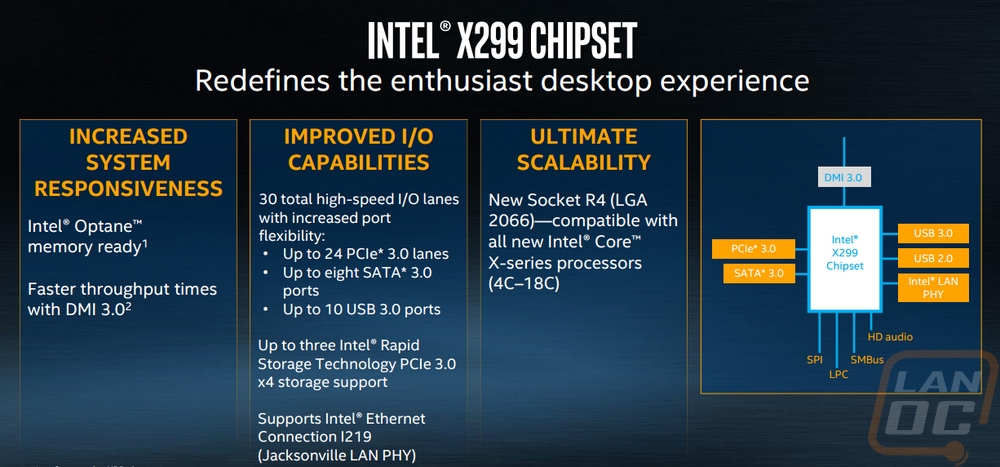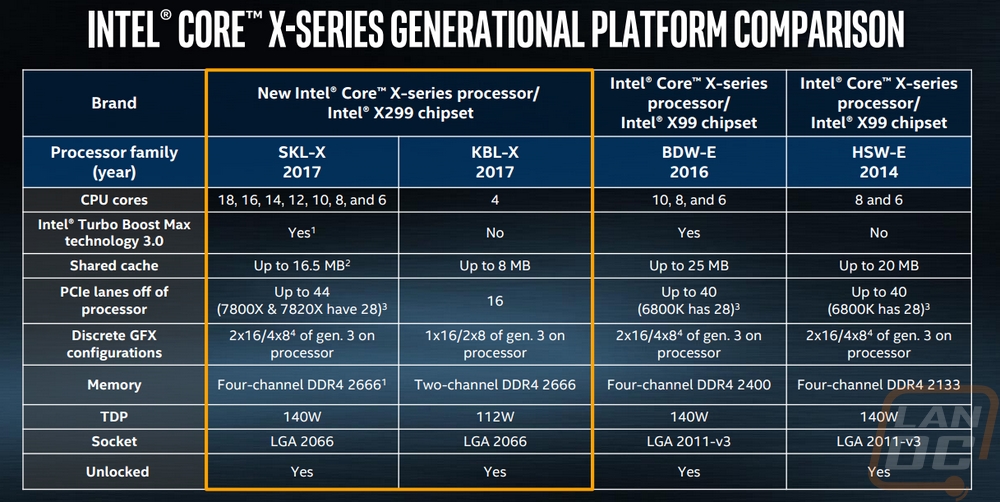To say that the X299 and Core X launch has been bumpy would be an understatement. During Computex, details were announced and the boards were shown off and Youtubers like Linus took to the streets literally and figuratively to voice their opinions. I myself have kept quiet, avoiding a lot of the drama, but mostly because I don’t like to voice an opinion on something from specification sheets and rumors. So I held out waiting to get everything into the office and take a closer look. Well, Intel sent over the new i9-7900X and the i7-7740X and today I’m going to talk a little more about everything and then dive into the performance. When that is all said and done, then we can finally start to look at the overall picture.
Product Name: Intel Core X Series i9-7900X and i7-7740X
Review Sample Provided by: Intel
Written by: Wes
Pictures by: Wes
Amazon Affiliate Link: Core i9-7900X and Core i7-7740X
X299 Testbench also supported by: Asus, Noctua, and Kingston
Intel Core X Series
Okay before getting into the fun stuff like testing and performance numbers we do need to run through some of the details on Intel’s new CPUs. I’m not going to go too far in depth because all of this information has been available for weeks now and everyone and their mom has broken it all down. But anyhow. What they are launching today is what they are calling the New Intel Core X-Series. Now typically they would be more specific with the architecture but this launch is a little different. They are launching both Skylake-X and Kaby Lake-X. For a while now Intel’s enthusiast platform has been a generation behind the mainstream CPUs. So this launch would normally be the Skylake-X launch with Kaby Lake-X next year if that trend continued. One could speculate what with Ryzen being launched and AMD finally having a pulse Intel may have finally had the incentive to work on catching the enthusiast platform back up.

The Kaby Lake based CPUs though are closer to the mainstream lineup than the typical enthusiast lineup though. They cut the integrated GPUs off but didn’t integrate the features that make the enthusiast platform so great. So the two SKUs (i7-7740X and the i5-7640X) only have to channels of memory just like on Z270 and they only have 16 PCIe lanes. For those of you who don’t know what those are, basically, they are communication lanes directly between the CPU and most of the board features. Most are used by the PCIe slots but they can also be used for USB ports, wireless, and other features. With fewer lanes on a CPU, you can’t have as much running at once. In this situation specifically, most X299 boards will have a lot of features that just won’t work when these CPUs are installed. Looking at the rest of the lineup the next two CPUs up are the i7-7800X and the i7-7820X, these are the 6 and 8 core CPUs. So with the Kaby Lake-X CPUs, I get that they would have fewer PCIe Lanes as that could be a carryover from the mainstream Kaby Lake CPUs, but the 6 and 8 core CPUs also have fewer lanes where their equivalent equals last year had more. This is where some people were upset with Intel, intentionally cutting these back in PCIe lanes to make the i9-7900X look better. No one wants to regress or lose features, so I don’t blame anyone for being upset about that one.


The other really unusual thing in the processor listing are the four up at the top with almost no information listed other than cores, names, and prices. I’m told that the 12-core Intel Core i9-7920X shipping in August and the i9-7940X, i9-7960X and 18-core Intel Core i9-7980X Extreme Edition processor, shipping in October. Again, speculating here, but I think these were all in response to AMDs Threadripper announcement. For right now the i9-7900X is the flagship and is one of the two CPUs we are checking out today. The whole i9 thing is another big change, up until now i7 was Intel’s highest designation but with the Core-X introduction, we now have i9’s years after the initial rumors that an i9 was coming.
The Kaby Lake CPUs have impressive base clock numbers with the i7-7740X having a 4.3 GHz base clock that boosts up just slightly to 4.5 GHz with Turbo Boost 2.0. The Skylake-X base clocks are lower with the current flagship i9-7900X being the lowest at 3.3 GHz. The 7900X and 7820X both boost up very well with 4.3 on Turbo Boost 2.0 and they both hit 4.5 GHz with Turbo Boost 3.0. The i7-7800X is a little bit of an odd man out with it not having Turbo Boost 3.0 and having a lower Turbo Boost 2 clock speed at 4 GHz. The pricing of the currently released CPUs mostly follows past Intel pricing with the flagship 7900X being $999. The i7-7800X though is cheaper now to compete with Ryzen. It should be noted that all of the new CPUs have different core/thread counts so there isn’t any chance of snagging a cheaper model and overclocking it for a deal. The 7900X has 10 cores and 20 threads and they move down from there to the 7820X with 8/16, the 7800X with 6/12 and then the Kaby Lake-X CPUs both have 4 with the 7740X being the only one with hyperthreading.

So beyond the basic improvements that the Kaby Lake/Skylake architectures bring to their respective CPUs there is one big improvement. The way cache is handled is now different. MLC is now four times larger than previous X series CPUs while still keeping the shared LLC as well but with just a little less available per core.



Beyond the CPUs, Intel is also introducing the new X299 chipset. They are moving from 2011 R3 to the new LGA 2066 socket. The new socket has the same cooler compatibility as the X99 and X79 before it with the built in mounting points that drop the need for an additional backplate. X299 also gained Intel Optane support. Intel provided a nice breakdown comparing the X99 and X299 platforms with both Skylake-X and Kaby Lake-X CPUs being separate to show the differences. The big thing being the PCIe breakdown that we already spoke about and the dual and quad channel memory as well. The bump in memory clock speeds is nice though, X299 now officially supports 266 MHz over the 2400 MHz on later generation X99 boards. X299 supports up to three PCIe x4 M.2 or U.2 connections on the chipset, up to 10 USB 3.0 ports, up to 8 SATA 3.0’s, and Intel’s I219 NIC.


The last area that has been a big issue as well is Intel’s implementation of RAID with the X299 chipset. So one of the big features is what they call Virtual RAID on CPU or VROC. This only works with the Skylake-X CPUs not the Kaby Lake-X CPU. It allows you to run RAID without having to use a RAID controller. This in it self is awesome, especially with high end PCs like you would be building with CPUs like the i9-7900X. The problem is Intel makes a lot of money from their enterprise hardware and this would be a big hit, so for RAID-1 and RAID-5 they will be forcing the use of a dongle that you will have to buy to gain access to Raid 1 and 5.
Here is a look at the new Socket. Like I said it uses the same mounts as the LGA 2011 cooler support at launch should include everything that supported 2011 before.


Here is a look at the new CPUs, they have the same thick heatspreader as Broadwell-E only on the bottom there are a few more pads to up the pin count to 2066 from 2011.






